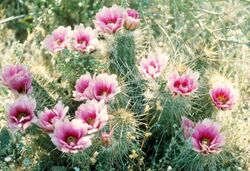Biology:Echinocereus fasciculatus
| Echinocereus fasciculatus | |
|---|---|

| |
| Scientific classification | |
| Kingdom: | Plantae |
| Clade: | Tracheophytes |
| Clade: | Angiosperms |
| Clade: | Eudicots |
| Order: | Caryophyllales |
| Family: | Cactaceae |
| Subfamily: | Cactoideae |
| Genus: | Echinocereus |
| Species: | E. fasciculatus
|
| Binomial name | |
| Echinocereus fasciculatus (Engelm. ex B.D. Jacks.) L.D. Benson
| |
| Synonyms | |
| |
Echinocereus fasciculatus, commonly known as pinkflower hedgehog cactus, is a clumping cactus (Cactaceae) with brilliant magenta flowers and long spines found in the Sonoran Desert.[2]:90
Description
Echinocereus fasciculatus forms loose groups consisting of five to 20 shoots. The green cylindrical to elongated shoots are 16 to 45 centimeters long and have a diameter of 4 to 7.5 centimeters. The shoot surface is not completely covered by the spines. There are eight to 18 ribs that are not clearly tuberculated. The two to four straight, light-colored central spines have a darker tip and are 2.5 to 7.5 centimeters long. One of them stands out. The eleven to 13 spreading, straight, whitish or grayish marginal spines are 1.2 to 2 centimeters long.
The broadly funnel-shaped flowers are magenta to reddish purple. They appear in the upper half of the shoots, are 5 to 6.2 centimeters long and reach the same diameter. The spherical, fleshy, initially green fruits later turn red.[3]
Distribution
Echinocereus fasciculatus is distributed in the United States in the states of New Mexico and Arizona and in the neighboring Mexican state of Sonora.
Taxonomy
The first description as Mammillaria fasciculata by Benjamin Daydon Jackson was published in 1895.[4] The epithet fasciculatus comes from Latin, means 'densely packed together' and refers to the cluster-forming reed-like shoots of the species. Wolfgang Blum and Michael Lange introduced the species as a subspecies to the species Echinocereus engelmannii in 1998. Nomenclature synonyms are Cactus fasciculatus (Engelm. ex B.D.Jacks.) Kuntze (1891, nom. illegal ICBN article 53.1), Neomammillaria fasciculata (Engelm. ex B.D.Jacks.) Britton & Rose (1923), Echinocereus engelmannii subsp. fasciculatus (Engelm. ex B.D.Jacks.) W.Blum & Mich.Lange (1998) and Echinocereus fendleri var. fasciculatus (Engelm. ex B.D.Jacks.) N.P.Taylor (1985).
References
- ↑ Butterworth, C.; Baker, M. (2017). "Echinocereus fasciculatus". IUCN Red List of Threatened Species 2017: e.T151819A121444783. doi:10.2305/IUCN.UK.2017-3.RLTS.T151819A121444783.en. https://www.iucnredlist.org/species/151819/121444783. Retrieved 27 May 2022.
- ↑ Sonoran Desert Wildflowers, Richard Spellenberg, 2nd ed., 2012, ISBN:9780762773688
- ↑ Anderson, Edward F.; Eggli, Urs (2005) (in de). Das grosse Kakteen-Lexikon. Stuttgart (Hohenheim): Ulmer. p. 197. ISBN 3-8001-4573-1.
- ↑ Darwin, Charles; Hooker, Joseph Dalton; Jackson, Benjamin Daydon (1893). Index Kewensis plantarum phanerogamarum : nomina et synonym omnium generum et specierum a linnaeo usque as annum MDCCLXXXV complectans nomine recepro auctore patria unicuique planta subjectis : sumptibus beati Caroli Roberti Darwin ductu et consilio Josephi D. Hooker. Oxford: Clarendon Press. doi:10.5962/bhl.title.66720.
External links
Wikidata ☰ Q1280374 entry
 |




